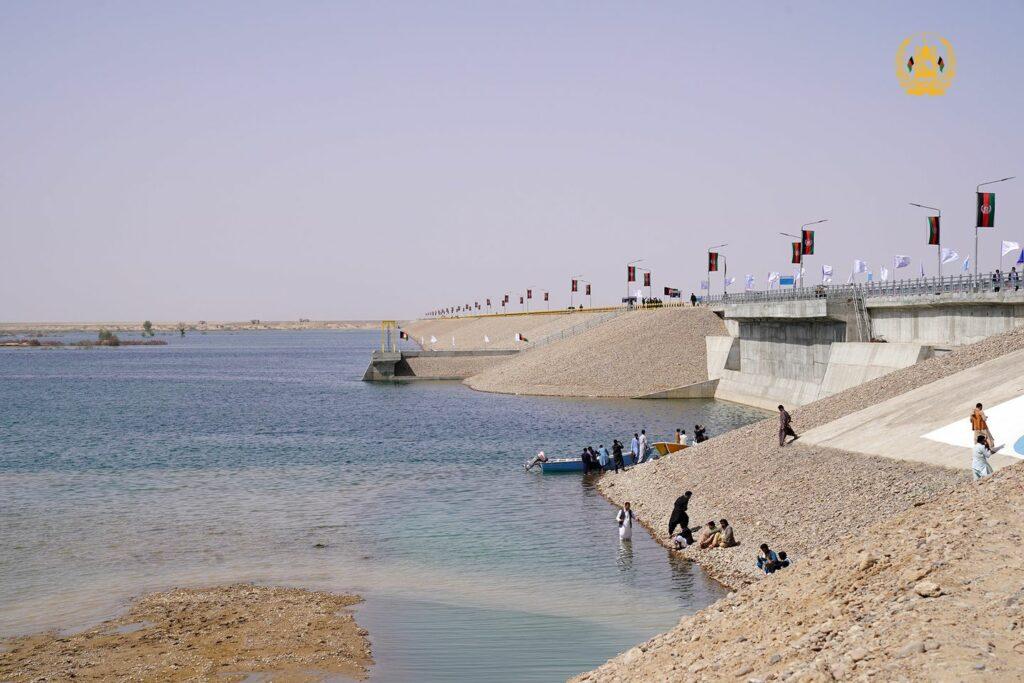ZARANJ (Pajhwok): The inauguration of Kamal Khan Dam in southwestern Nimroz will not only stop the flow of water into neighboring Iran but also irrigate thousands of hectares of land and create job opportunities.
Kamal Khan Dam, along with Salma Dam in Herat and Bakhsh Abad in Farah, is one of the largest dams in western Afghanistan. It was built 18 km south of Zaranj city in Nimroz province, on the Helmand River.
The construction of the dam on the Helmand River in Afghanistan took four years (from spring 1396 solar year to 1399) at a cost of 78 million US dollars.
The dam in Char Barjak district of Nimroz was inaugurated and put into operation on Wednesday by President Mohammad Ashraf Ghani.
“After 700 years, the Kamal Khan Dam will store water, Nimroz will get green, and in the next four years, you will see the greenery and vibrancy of Afghanistan,” Ghani said.
He added that Helmand water had been flowing out of Afghanistan for centuries, but was now in the hands of Afghans in line with the water agreement between Iran and Afghanistan.
Earlier, Iran had expressed concern about the construction of the dam.
SaeedKhatibzadeh, spokesman for the Iranian Ministry of Foreign Affairs, said: “The Helmand River has a defined legal regime and according to an agreement signed between the two countries in 1351 and approved by the legislatures of both countries, Iran’s water rights are completely obvious and the Afghan government is bound to this right.”
However, Afghan President Ashraf Ghani has said that Kabul was committed to implementing the agreement.
Located in ChaharBurjak district, the Kamal Khan dam has a 52 million cubic meters capacity and will irrigate 174,000 hectares of land, local officials say.
Construction work on the dam, located 95 kilometers from Zaranj, the provincial capital, got under way in 1974. But the project’s completion was delayed by decades of war.
Why the dam is named after Kamal Khan?
According to the Afghanistan National Water Regulatory Authority (NWRA), Kamal Khan Sanjarani, the son of SardarNawab Khan and the grandson of Pesarjan Bek, was one of the BalochSanjarani rulers who lived in this land about seven hundred years ago. He was a national, patriotic, popular figure.
Kamal Khan, thinking of controlling the stray waters of Helmand, wanted to manage the fertile land of that area by fertilizing it, and to bring about change in the lives of common people, he wanted to pave the way for development and prosperity of Sistan.
At that time, in cooperation with local people, Khan built a storage using wood, stone and mud to store water and irrigate their lands; But later this dam was destroyed by one of the kings of that time.
Benefits of Kamal Khan Dam
RahmatOmari, spokesman for the Nimroz governor, told Pajhwok that the dam would irrigate 80,000 hectares of land in Nimroz province.
He added with the operation of this dam, hundreds of people in agriculture and trade sectors would find a favorable environment and it would pave the way for national and international tourists.
In addition, the dam project would usher into continuous use of water and water resources and result into less reliance on seasonal rains. The dam would control water flow to neighboring countries, prevent water loss, soil degradation, floods and its financial and human losses.”
“Other benefits of the Kamal Khan Dam include fish farming, tempering the region, creating recreation areas and attracting tourists, reducing the negative effects of drought and its problems.”
According to the governor’s spokesman, there are 80,000 hectares of agricultural land in Nimroz province, and with the use of this dam, all lands in this province will turn green.
He said the dam would be used to irrigate central lands, Kong district, Chakhansur district and ChaharBurjak district of Nimroz province.
A regular program must be designed: experts
Kamal Khan Dam was one of the basic and fundamental projects in the country, the construction of which first began during the rule of Sardar Mohammad Daud Khan; But due to the continuation of war and insecurity in the country, its construction was restricted.
Mohammad IshaqShahbaz, a professor at a private university in Nimroz province, told Pajhwok that the Kamal Khan Dam project was one of Afghanistan’s most fundamental development projects over the past decade, and that operating the dam would boost the country’s revenue.
He added: “Nimroz is one of the provinces that has the most agricultural lands and its climate is favorable for cultivation.”
He added that through the growth of agriculture, thousands of people will be directly and indirectly employed.
Sacrifices rendered during construction process
Interior Ministry spokesman Tariq Arian says 35 attacks had been staged on the Kamal Khan Dam in the past two years, killing and wounding 39 security personnel and capturing 28 Taliban insurgents. He said four landmines and 98 attacks on the dam had been thwarted.
Govt message to people
President Ashraf Ghani at the opening ceremony of the dam addressing the people of Nimroz, he said that this dam after 700 years will make Nimroz green. All Afghans should play a key role in maintaining this dam.
ZimralAhadi, the governor of Nimroz, announced that the process of generating electricity from this dam would begin, which will pave the way for agricultural growth in the province.
The governor pledged to work with people to maintain the dam, which would provide facilities such as a good recreational area for tourists, amusement parks for Nimroz people and other facilities.
Sa/ma
Views: 212
